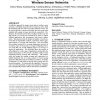Free Online Productivity Tools
i2Speak
i2Symbol
i2OCR
iTex2Img
iWeb2Print
iWeb2Shot
i2Type
iPdf2Split
iPdf2Merge
i2Bopomofo
i2Arabic
i2Style
i2Image
i2PDF
iLatex2Rtf
Sci2ools
SENSYS
2003
ACM
2003
ACM
Integrated coverage and connectivity configuration in wireless sensor networks
An effective approach for energy conservation in wireless sensor networks is scheduling sleep intervals for extraneous nodes, while the remaining nodes stay active to provide continuous service. For the sensor network to operate successfully, the active nodes must maintain both sensing coverage and network connectivity. Furthermore, the network must be able to configure itself to any feasible degrees of coverage and connectivity in order to support different applications and environments with diverse requirements. This paper presents the design and analysis of novel protocols that can dynamically configure a network to achieve guaranteed degrees of coverage and connectivity. This work differs from existing connectivity or coverage maintenance protocols in several key ways: 1) We present a Coverage Configuration Protocol (CCP) that can provide different degrees of coverage requested by applications. This flexibility allows the network to self-configure for a wide range of applications ...
Coverage Maintenance Protocols | Network Connectivity | Sensor Network | Sensor Networks | SENSYS 2003 |
| Added | 05 Jul 2010 |
| Updated | 05 Jul 2010 |
| Type | Conference |
| Year | 2003 |
| Where | SENSYS |
| Authors | Xiaorui Wang, Guoliang Xing, Yuanfang Zhang, Chenyang Lu, Robert Pless, Christopher D. Gill |
Comments (0)

